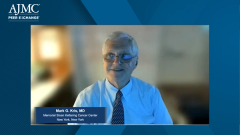
Driver Mutations and Cancer Care
How the identification of certain driver mutations analyzed by genomic assays can be applied into oncology treatment.
Episodes in this series

Bruce Feinberg, DO: From a standpoint as a clinician, unfortunately it's not a perfect world in which you just get that one mutation identified. You're going to have lots of signal to noise problems. That gets back to what Eugean [Jiwanmall, MPH, MBA,] was referencing as to one, can you identify which is the driver mutation. Then even that to the less experienced clinician asked you now to know if the mutation is the mutation that is known to affect the protein in the way that's related to the cancer. That gets into that noise problem. How do you approach that? How do you approach that not just in the way because you've been immersed in it now for decades? You're a “mutationist.” How do you approach that in terms of training the fellows?
Mark G. Kris, MD: I've been surrounded by smart people. There are people that know molecular biology. First, just the basic things: They can tell if a certain mutation is likely a driver mutation. There is medical literature that can do that, and it's interesting that people that do that for a living. Also, please remember when you get a test a next-generation sequencing test, that test is not just signed off by a laboratory scientist. It is signed off by a pathologist, the same way that a pathologist would sign off the analysis of a tumor specimen that was removed in surgery.
The scientists in the pathology world look at the output of those machines that generate that genomic data. They make a call the same way they make a call looking at a microscope slide— is this cancer or is this not—they make those calls. When we get these reports, they've gone through the scientific vetting, I'll call it the technical validity of the test. They then go into the significance of it and then they add into that interpretation. I think what we've seen in most of the commercial tests, I know the ones in our situation, I've never seen a report that came up from [The University of Texas MD Anderson Cancer Center]. We have a whole team of people that goes through the medical literature, looks at mutations by a thorough analysis of literature and says, is that mutation likely to be a driver or not likely to be significant? Does that mutation have an associated therapy with it. A lot of the work is done behind the scenes in those reports. It's not like I'm just given the read out of an alumina sequencer. It's gone through a number of levels of vetting by really, really smart people.
Transcript edited for clarity.
Newsletter
Stay ahead of policy, cost, and value—subscribe to AJMC for expert insights at the intersection of clinical care and health economics.







































